
Places to visit in Australia
Australia is a land of dreams. From the sacred legends of the aboriginal Dreamtime, when the great spirits conjured the coral reefs, rainforests, and scorched red deserts, to armchair travelers who describe Australia as their dream destination, the Land Down Under deserves all the hype. The world’s smallest continent and largest island, Australia is almost the same size as the United States but with a population the size of New York State and some of the quirkiest wildlife on the planet.
Top it all off with a laid-back feel and friendly people, and it’s no wonder Australia scores top billing on bucket lists around the world. Create your own adventure with our list of the top attractions in Australia
1. Sydney Opera House
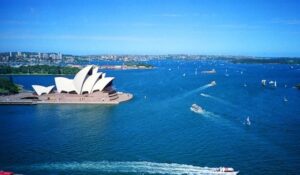
Mention “Sydney, Australia” and most people think of the Opera House. Shaped like huge shells or billowing sails, this famous building on Sydney’s Bennelong Point graces the list of UNESCO World Heritage Sites and is one of the world’s great architectural icons. The location is stunning. Water surrounds the structure on three sides, and the Royal Botanic Gardens border it to the south.
Danish architect, Jørn Utzon won an international competition for its design but withdrew from the project after technical and financing problems. Construction was finally completed in 1973 at a cost ten times the original budget. By this time, Utzon had left the country never returning to see his magnificent creation.
Today, you can enjoy a performance here; dine at one of the restaurants; or take a tour of the building, which encompasses theaters, studios, a concert hall, exhibition rooms, and a cinema. But it’s far more impressive viewed from a distance. One of the best sites to photograph the Opera House is Mrs Macquarie’s Chair in the Royal Botanic Gardens, or you can hop aboard a harbor cruise or ferry for yet another picturesque perspective.
2. Great Barrier Reef Marine Park

Visible from outer space, the World Heritage-listed Great Barrier Reef is one of the largest living structures on the planet. In 1975, the Great Barrier Reef Marine Park was established to protect its fragile ecosystems, which include more than 3,000 coral reefs; 600 continental islands, including the beautiful Whitsunday group; 300 coral cays; and inshore mangrove islands. One of the seven wonders of the natural world, the park stretches for 2,300 kilometers along the state of Queensland, on Australia’s east coast (that’s about the distance between Mexico and Vancouver). Diving and snorkeling are spectacular. The astounding array of marine life includes soft and hard corals, more than 1,600 species of tropical fish, sharks, dugongs, dolphins, turtles, rays, and giant clams. If you prefer to stay dry, you can see the reef from underwater viewing stations and glass bottom boats. On the mainland, Cairns, Port Douglas, and Airlie Beach are the main launching points for tours.
3. Uluru-Kata Tjuta National Park
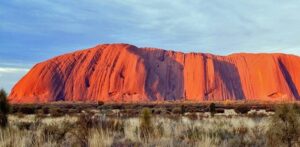
Deep in the heart of Australia’s Red Centre, Uluru (formerly Ayers Rock), is one of the most photographed natural wonders in the country. The striking red monolith forms the centerpiece of Uluru-Kata Tjuta National Park, a World Heritage Area jointly managed by Parks Australia and the traditional landowners, the Aṉangu people. Uluru, meaning “shadowy place” in the local aboriginal dialect, rises to a height of 348 meters from the surrounding plain, with most of its bulk hidden beneath the earth’s surface. Also in the park are the red dome-shaped rocks called Kata Tjuta (the Olgas). As the sun dips in the sky, sightseers gather to watch the colors of Uluru and Kata Tjuta transform in the shifting light. A great way to appreciate these sacred sites is to join a tour led by Aboriginal guides and rangers.
4. Sydney Harbour Bridge
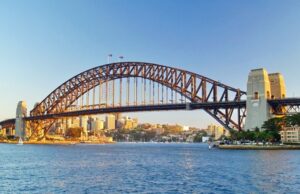
Along with the Opera House, the Sydney Harbour Bridge is one of Australia’s most famous tourist attractions. Affectionately called “the Coathanger,” this impressive feat of construction is the largest steel arch bridge in the world. It was completed in 1932, 40 years before the Sydney Opera House. Rising 134 meters above the harbor, the bridge spans 500 meters, connecting Sydney’s North Shore to the central business district. In addition to the pedestrian path, two railway lines extend over the bridge, as well as eight lanes for road traffic, and the direction of each lane can be switched to accommodate traffic flow.
One of the top things to do in Sydney is a guided ascent to the top of the bridge, where you can enjoy spectacular views over the harbor and city. For an overview on the bridge’s history and construction visit the museum in the southeastern pier. Interestingly, Paul Hogan, of Crocodile Dundee fame, worked as a painter on the bridge before rocketing to international stardom.
5. Blue Mountains National Park

A UNESCO World Heritage Site, beautiful Blue Mountains National Park lies 81 kilometers west of Sydney and is a popular day trip from the city. Named for the blue haze emanating from the many eucalyptus trees, this stunning park protects more than 664,000 acres of wilderness and encompasses dramatic gorges, waterfalls, aboriginal rock paintings, and 140 kilometers of hiking trails. The most famous attractions in the park are the towering sandstone rock formations called the Three Sisters. Other highlights include the Katoomba Scenic Railway, the world’s steepest, which whisks passengers down the Jamison Valley through a cliff-side tunnel into an ancient rainforest, and the Skyway, Scenic Cableway, and Scenic Walkway, which all offer elevated views of the dense forests. Hiking, abseiling, rock climbing, mountain biking, and horseback riding are all popular things to do in the park.
6. Melbourne

Melbourne, Australia’s second largest city, is a popular stop on many Australian itineraries – especially for culture vultures. Galleries, theaters, restaurants, shops, and its distinctly European feel are the main draws of this sophisticated city on the Yarra River. It’s also a green city, with parks, gardens, and open spaces occupying almost a third of its total area. Highlights of the city include the Royal Botanic Gardens; Federation Square; the National Gallery of Victoria; and the Melbourne Cricket Ground, where sports fans can watch cricket in the summer and Australian Rules football in the winter. Shoppers flock to the elegant Royal Arcade on Bourke Street, as well as Chapel Street; the Melbourne Central Shopping Center; and the Queen Victoria Market, which has been selling fruits, vegetables, clothes, and crafts for more than a century. To the east, greater Melbourne extends into the beautiful Dandenong Ranges, and in the south to the Mornington Peninsula, where many locals escape for day trips and seaside getaways.
7. Bondi Beach

Bronzed bodies, blond sand, backpackers, and surf – throw it all together and you get one of the world’s most famous beaches. Only 15 minutes by car from the city center, Bondi Beach is home to one of the oldest surf life saving clubs in the world. It’s also a great spot for a seaside stroll or picnic, and crowds of tourists and locals gather here to celebrate Christmas and ring in the New Year. A great way to soak up the sea views is to stroll along the scenic Bondi to Bronte coastal walk, which begins at the southern end of the beach and follows the coastline for six kilometers along sandstone cliffs. Shops, cafes, and restaurants lie across the street from this famous coastal strip. Other attractions around the beach include the Sunday markets, ocean pool, and skate park. Take care when swimming at Bondi. Strong rip tides often sweep unsuspecting swimmers out to sea, especially at the southern end of this kilometer-long strand, so swimmers should stay between the flags. There’s a reason the Aussies made a reality TV show called Bondi Rescue.
8. Daintree National Park
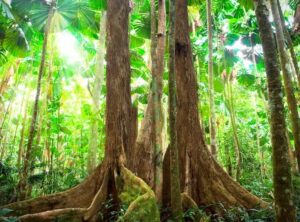
A Wet Tropics World Heritage Area, Daintree National Park in Far North Queensland is among the most ancient ecosystems on Earth. The area belongs to the Eastern Kuku Yalanji Aboriginal people, and many of its natural features hold great spiritual significance. The park encompasses two main sections: Mossman Gorge, where crystal clear waters gush over granite boulders, and Cape Tribulation, one of the most beautiful places to visit in Australia, where rainforest meets reef along the white sandy beaches of the Coral Sea. This stunning stretch of coast is one of the few places in the world where two of the planet’s richest ecosystems converge. The park’s astounding biodiversity includes more than 18,000 plant species and a vast array of animal species, including the cassowary, crocodile, giant blue Ulysses butterfly, and the secretive Bennett’s tree kangaroo. The resort town of Port Douglas, just south of the park, is a great base to arrange wilderness safaris into the park.
9. Fraser Island
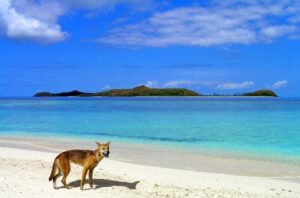
World Heritage-listed Fraser Island, between Bundaberg and Brisbane off Australia’s east coast, is the largest sand island in the world and one of Australia’s top outdoor adventures – especially for four-wheel drive enthusiasts. Along windswept Seventy Five Mile Beach, you can see the rusted hulls of shipwrecks, the colored sandstone cliffs of The Cathedrals, and the bubbling fish-filled rock pools called Champagne Pools.
Venturing inland, highlights include crystal-clear freshwater creeks and lakes, some fed by springs, others perched amid towering sand dunes, and ancient rainforests filled with an amazing diversity of plants and animals. Sharks, dolphins, and whales prowl the waters, and the island’s fauna includes wild horses, dingoes, bats, sugar gliders, and more than 300 species of birds. Access to Fraser Island is by ferry from Rainbow Beach and Hervey Bay. Four-wheel drive vehicles are essential as the island has no sealed roads.
10. Kakadu National Park
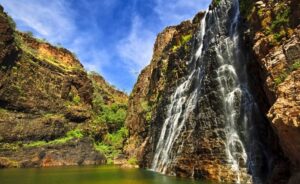
Kakadu National Park, in the Top End or the Northern Territory, is a World Heritage Site and one of the planet’s great wilderness areas. Covering more than 19,840 square kilometers, Kakadu is the largest national park in Australia and the second largest in the world. Within its borders lie monsoon rainforests, mangrove swamps, rivers, gorges, ancient rock paintings, wetlands, and waterfalls, as well as an astounding diversity of wildlife. In addition to the many mammals, reptiles, and fish, more than 300 different species of birds make their home here, and both freshwater and saltwater crocodiles lurk in the wetlands. You can explore the park’s diverse ecosystems by car, air, boat, or on foot via the vast network of hiking trails. Note that during the wet season (Nov-April), many roads and attractions close due to heavy flooding.
11. Great Ocean Road

Most top tourist destinations have spectacular driving routes, and for Australia, one of its best is the Great Ocean Road. Built to provide employment during the Depression, the road stretches for 300 kilometers along Australia’s southeast coast, from the surfing town of Torquay to the town of Allansford, near Warrnambool, in the state of Victoria. The top attraction along the road is Port Campbell National Park, with the wind and wave-sculpted rock formations known as the Twelve Apostles, London Bridge, the Arch, and Loch Ard Gorge. From a helicopter tour, these rock formations look like giant puzzle pieces, lashed by the pounding surf of the Southern Ocean. Other highlights along the road include the popular holiday resort town of Lorne and Otway National Park, an area of dense eucalyptus forests, fern-filled rain forests, hiking trails, and waterfalls.
12. Broome and the Kimberley region
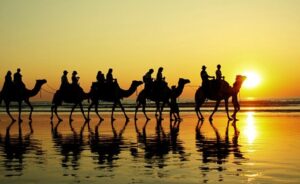
Once the pearl capital of the world, Broome, in Western Australia, is now a booming tourist town and the gateway to the spectacular Kimberley region. Its star tourist attraction, Cable Beach, with seemingly endless white sands and turquoise water is one of Australia’s best beaches, and riding camels at sunset is one of the most popular things to do here. Other highlights include the Broome Historical Museum; Broome Crocodile Park; and the Staircase to the Moon, a phenomenon during certain conditions between March and October, where the moonlight creates an optical illusion of steps leading to the moon. From Broome, you can explore the rugged and remote Kimberley region and its incredible natural attractions like the Horizontal Waterfall, Cape Leveque, the Gibb River Road, Purnululu (Bungle Bungle) National Park, and the stunning cascades of Mitchell Falls.
13. Kangaroo Island
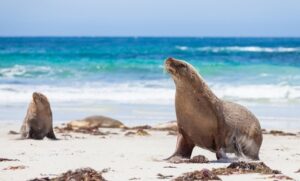
Nature takes center stage at beautiful Kangaroo Island off the Fleurieu Peninsula in South Australia. Kangaroos hop along the powdery shores, sea lions and penguins frolic in the crystal-clear waters, and koalas cling to the fragrant eucalyptus trees. Diving is also excellent. You can spot sea dragons in the temperate waters, and many wrecks lie offshore. The striking, wind-sculpted rock formations, known as the Remarkable Rocks and Admirals Arch in Flinders Chase National Park are other distinctive features of the island, and you’ll find plenty of hiking trails along the soaring sea cliffs and in the pristine forests. Foodies, too, will be in heaven. Creamy cheeses, Ligurian honey, and fresh seafood grace the plates in local restaurants. To get here, you can fly direct to the island from Adelaide or catch a ferry from Cape Jervis on the Fleurieu Peninsula.
14. Cradle Mountain-Lake St. Clair National Park

Cradle Mountain-Lake St. Clair National Park is a national tourism treasure and a nirvana for nature lovers. Sparkling lakes, serrated dolerite peaks, alpine heathland, and dense forests characterize the raw, glacier-carved wilderness here, and 1,616-meter Mount Ossa is one of the park’s most distinctive features and the highest point in Tasmania. As you might expect, hiking here is fantastic. Favorites include the Weindorfer Walk, a six-kilometer loop through dense forests, and Lake Dove Walk, with breathtaking vistas of Cradle Mountain (1,545 meters). Stand on the summit of Cradle Mountain, and you can soak up stunning views of the central highlands. Experienced hikers can also tackle the famous 80-kilometer Overland Track, which runs south from Cradle Valley to stunning Lake St. Clair, Australia’s deepest lake. Keep an eye out for Tasmanian devils, wombats, wallabies, pademelons, and platypus among the many species of weird and wonderful wildlife.
You May Also Like
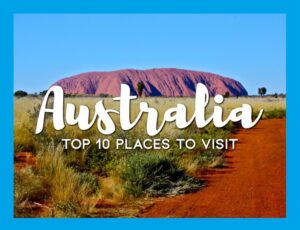
Top 10 Places to visit in Australia

20 Top Places to Visit in New York

30 Top Tourist Attractions in the USA
